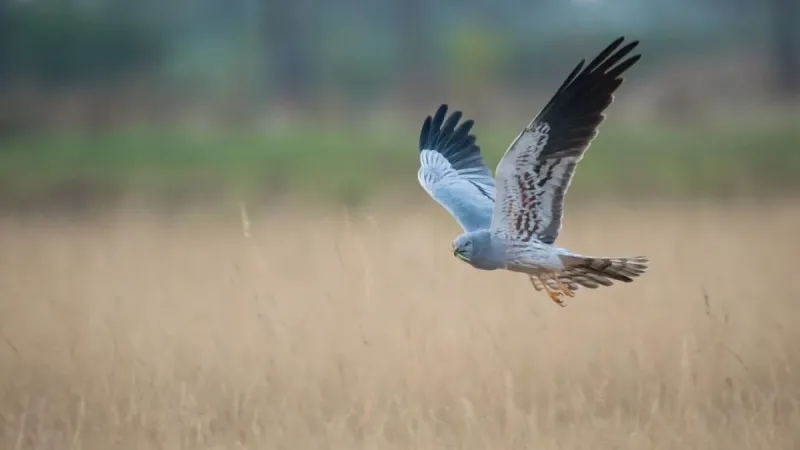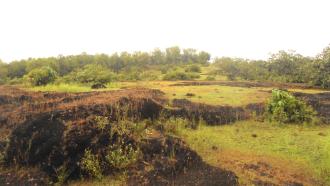
A Montagu's Harrier in a typical grassland habitat. Photo: Vinod M Kumar.
New research from India has revealed a surprising and crucial ecological role for two species of strictly carnivorous raptors: the Pallid Harrier (Circus macrourus) and Montagu's Harrier (Circus pygargus). These apex predators, known for their sharp talons and keen eyesight, are now confirmed to be secret gardeners, effectively dispersing viable plant seeds across India's threatened grassland and savanna ecosystems through their droppings. This eight-year study, conducted across three key wintering regions in India, provides the first evidence of this phenomenon for these migratory species in their non-breeding range. The study by researchers from the Ashoka Trust for Research in Ecology and the Environment (ATREE), and the Manipal Academy of Higher Education, Manipal, demonstrates a vital process known as secondary seed dispersal, or diploendozoochory.
The investigation, which spanned from 2016 to 2023, involved the collection and analysis of 3,216 harrier pellets, the undigested remains of prey that raptors regurgitate. The most striking finding was that seeds were present in 21% (670) of these pellets, with an impressive average of 43.5 seeds per pellet. The sheer volume and diversity of the seeds were remarkable, with researchers identifying intact seeds from 137 plant species across 23 families, including 64 monocots and 73 dicots. To prove that these seeds were not just passing through but were actually viable, the team sowed 6,253 undamaged seeds retrieved from the pellets, and 11% (674) successfully germinated. This germination success is proof that the harriers are capable of dispersing viable seeds, suggesting that the seeds can survive the powerful digestive enzymes within the raptors' guts.
The mechanism at play is secondary seed dispersal, or diploendozoochory, an ecological process where a predator consumes an animal (the prey) that has already consumed seeds. The harriers, being strictly carnivorous, do not eat plants directly. Instead, they prey on primary seed dispersers, such as granivorous (seed-eating) birds and small mammals like rodents. The seeds, which might otherwise be destroyed by the powerful gizzards (part of a bird’s stomach) of the prey animals, are essentially rescued when the harrier consumes the prey.
What's in a Name? The process of secondary seed dispersal by a predator is called diploendozoochory. It literally means double internal animal dispersal—the seed is dispersed twice: first by the small animal that ate it, and second by another carnivore, the harriers, in this case, that ate the small animal! |
By surviving the harrier's digestive tract and being regurgitated in the pellet, the seeds are deposited away from the parent plant, often in a new, fertile location. The study's statistical analysis confirmed this link, showing that the occurrence of seeds in the pellets was significantly associated with the co-occurrence of birds and mammals in the harrier's diet, but not with insects or grasshoppers. This highlights the harrier's critical role in interrupting seed predation by seed-eating vertebrates, thereby enhancing the plant's chances of survival and dispersal.
Harriers are long-distance migrants, and their ability to move between multiple wintering sites, called itinerant behaviour, makes them potential mobile links that connect fragmented grassland patches across the Indian subcontinent. This ability to move seeds over long distances is vital for maintaining plant gene flow and enabling the colonisation of new, distant habitats, which is particularly important in India's degraded and fragmented grassland-savanna ecosystems. The research noted spatial variation in seed richness, with the Deccan region showing the highest diversity. This is likely due to the vast pastures and grazing lands around the roosting sites that support a greater variety of plant species. While the harriers primarily aid native species, the pellets also contained seeds from eight crop species and three invasive species, including the highly problematic Lantana camara, though the overall dispersal of invasive seeds was found to be low.
Research on diploendozoochory by strictly carnivorous raptors has historically been limited, especially for migratory species in their non-breeding grounds. The study's extensive eight-year duration and broad geographical coverage provide a robust dataset. Its finding that seed presence is directly linked to the consumption of birds and mammals is a key advancement in understanding the specific pathways of secondary dispersal. By demonstrating that harriers interrupt seed predation, the research clarifies a crucial, underappreciated ecosystem service.
However, the study also noted several limitations. The seed germination experiment was conducted in a single location (Tamil Nadu) with different climatic and soil conditions than the collection sites, which may have influenced the germination rates. Furthermore, the seeds were extracted from stored pellets, which could have surpassed the natural dormancy period of some species. Finally, the researchers faced challenges in identifying both the harrier species responsible for each pellet and many of the seeds to the species level due to a lack of comprehensive reference collections. Future research, they suggest, should incorporate advanced techniques like DNA metabarcoding to achieve greater precision in species identification.
The findings of this research hold significant benefits for conservation and sustainable agriculture. By confirming the harriers' role as effective seed dispersers, the study elevates their conservation status from merely apex predators to essential ecosystem engineers. Conserving these migratory raptors and their prey-rich grassland habitats is no longer just about protecting a bird species but it is about safeguarding a free, natural ecosystem service that maintains plant biodiversity and facilitates the resilience of fragile ecosystems.
This article was written with the help of generative AI and edited by an editor at Research Matters.
Editor's Note: There was a typo that has been rectified. The error is regretted.






